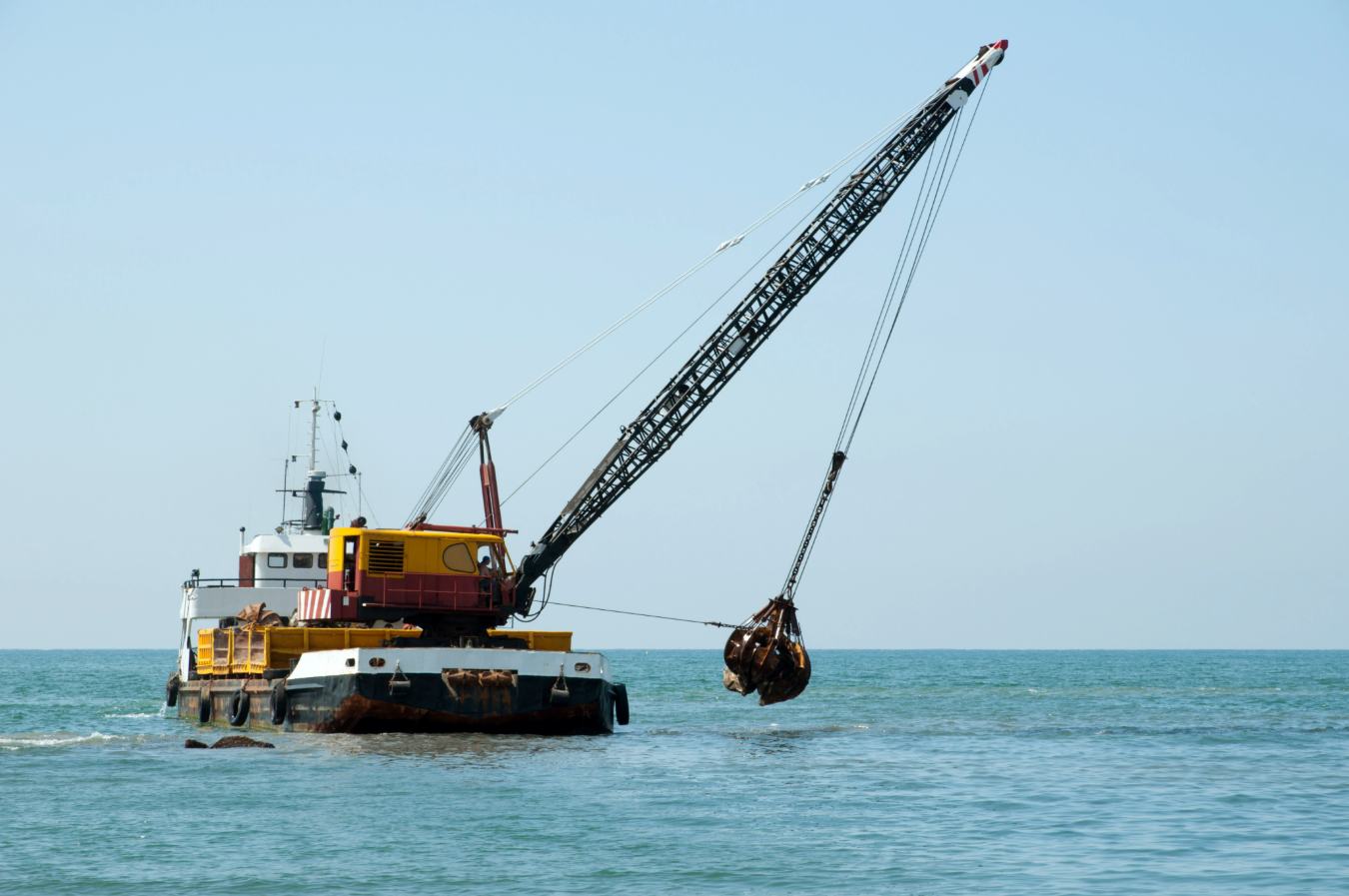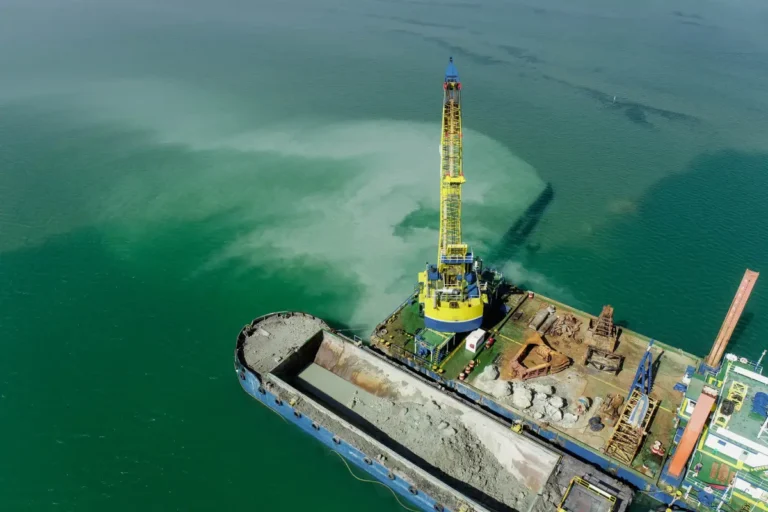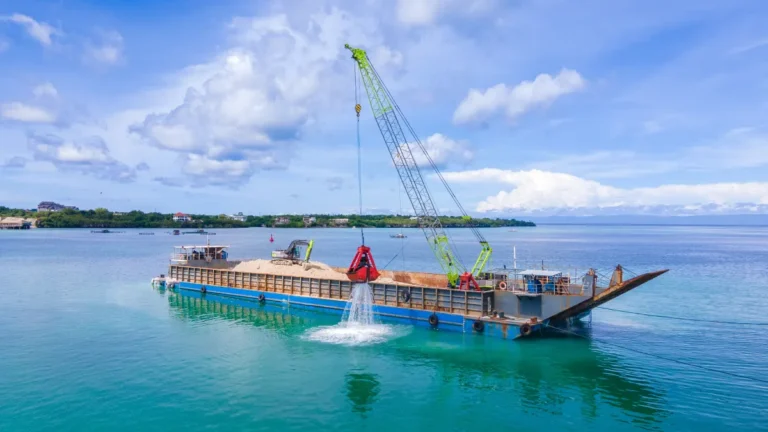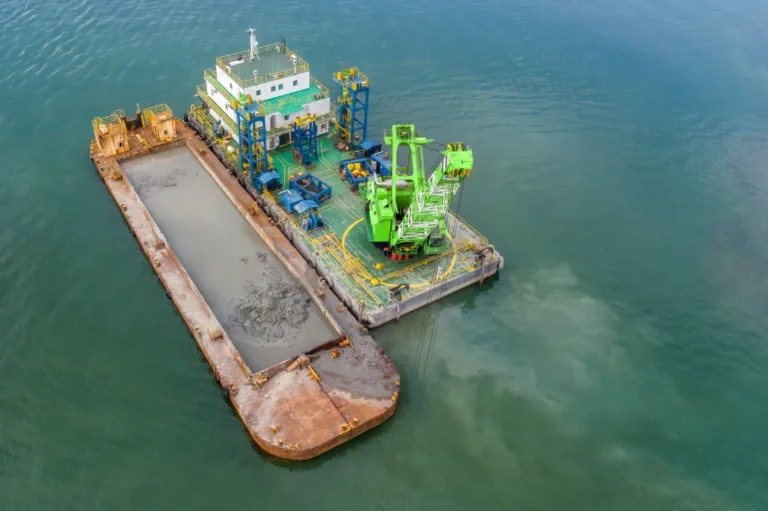Renting a suction dredge is a practical and cost-effective solution for industries that require efficient sediment removal, underwater excavation, or land reclamation. Suction dredge rental allows businesses to access advanced dredging technology without the long-term financial commitment of ownership. Whether you are working on a mining project, harbor maintenance, environmental cleanup, or construction site preparation, renting the right dredge can significantly enhance project efficiency. Choosing between a standard suction dredge and a more robust cutter suction dredger depends on factors like sediment type, project scale, and operational complexity.
However, selecting the right suction dredge rental service involves more than just comparing prices. It requires a comprehensive understanding of factors such as equipment type, rental costs, technical support, and supplier reputation. From evaluating the dredging requirements and site accessibility to ensuring compliance with environmental regulations, making an informed choice can optimize project outcomes. This guide will help you navigate the key considerations and practical tips for renting a suction dredge, ensuring that you choose the best equipment and service provider for your specific needs.
What is a Suction Dredge?
A suction dredge is a powerful piece of equipment designed to remove sediments, silt, and debris from the bottom of water bodies such as rivers, lakes, harbors, and reservoirs. It works by creating a vacuum that sucks up the material along with water and pumps it through a pipeline to a designated disposal or processing site. Suction dredge rental is commonly used in industries like mining, environmental cleanup, and construction, where temporary dredging operations are needed.
The primary function of a suction dredge is to excavate underwater sediments and transport them efficiently to another location. This process helps in maintaining navigable waterways, extracting valuable minerals, or preparing construction sites. Suction dredges are also essential for environmental dredging, where contaminated sediments need to be removed without disturbing the aquatic ecosystem significantly.
Difference Between Standard Suction Dredge and Cutter Suction Dredger
There are two main types of suction dredges commonly used in industrial applications: the standard suction dredge and the cutter suction dredger (CSD).
- Standard Suction Dredge:
- Typically used for soft, loose sediments such as silt and sand.
- Works by using a suction pump to draw in water and sediment directly from the bed.
- Ideal for maintenance dredging in calm, shallow waters.
- Simple design with fewer components, making it cost-effective for small-scale projects.
- Cutter Suction Dredger (CSD):
- Equipped with a rotating cutter head that breaks up compacted or hard sediments before suction.
- Suitable for more demanding tasks such as removing clay, gravel, or consolidated soils.
- Ideal for larger, industrial-scale dredging operations, including land reclamation and deep harbor maintenance.
- More complex and robust, usually requiring skilled operators for efficient use.
Typical Components and Features
Standard Suction Dredge Components:
- Suction Pump: The core component that generates vacuum pressure to draw sediments.
- Suction Pipe: A flexible or rigid hose that conveys the slurry from the bed.
- Discharge Pipeline: Transfers the dredged material to the designated area.
- Floatation Device: Keeps the dredge afloat during operation.
- Control Unit: Manages the suction power and flow rate.
Cutter Suction Dredger Components:
- Cutter Head: A rotating apparatus that dislodges and fragments compacted material.
- Cutter Shaft: Connects the cutter head to the dredge body, driven by hydraulic motors.
- Suction Inlet: Positioned directly behind the cutter head to collect broken-up sediment.
- Dredge Pump: Creates the suction force needed to move the slurry.
- Spud Poles: Anchoring mechanisms that stabilize the dredger during excavation.
- Discharge Pipeline: Similar to the standard model but typically reinforced for handling abrasive materials.
How Suction Dredges Work
The suction dredging process starts with positioning the dredge at the target site. For standard suction dredges, the suction pipe is lowered into the sediment, where the pump creates a vacuum to draw the slurry through the pipeline. In contrast, a cutter suction dredger begins by using its cutter head to break up the compacted material before suction.
Once the sediment is mobilized, the dredge pump continuously transports the slurry through a discharge pipe, which may lead to a processing plant, containment area, or disposal site. The entire operation is typically monitored through a control system, allowing operators to adjust suction power, cutter speed, and flow rates as needed.
By understanding the differences and functions of each dredge type, businesses can make more informed choices when opting for suction dredge rental. Selecting the right equipment based on the project’s demands ensures efficient sediment removal and optimal project outcomes.
Common Applications of Suction Dredge Rental
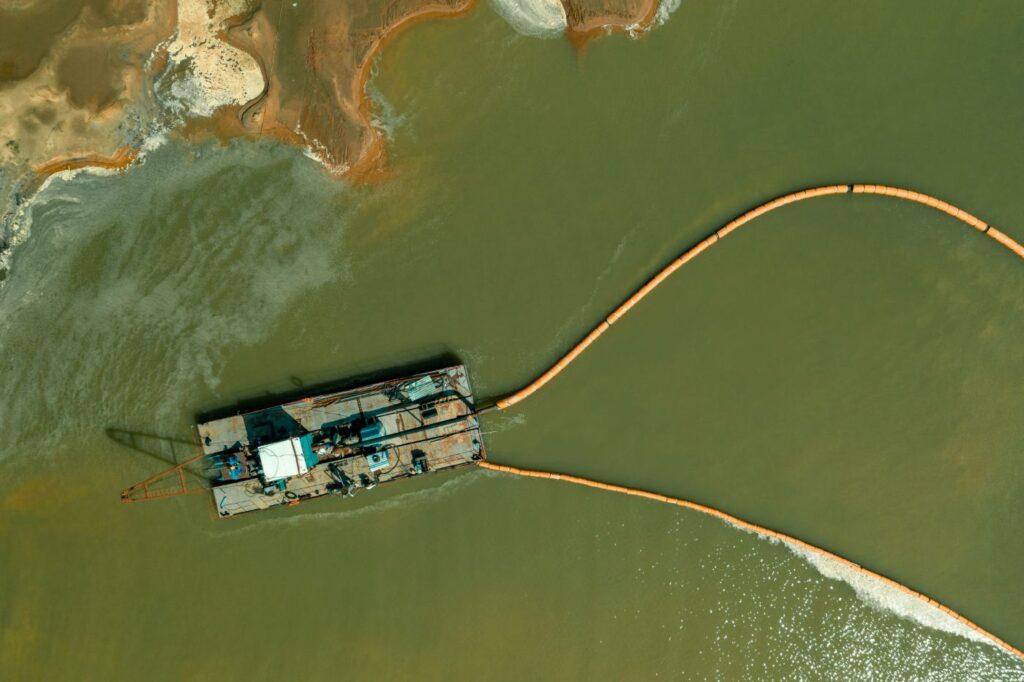
Suction dredge rental is a cost-effective and flexible solution for industries that require sediment removal or underwater excavation. Depending on the project requirements, businesses can choose between standard suction dredges and more powerful cutter suction dredgers (CSD). Here are some of the most common applications where renting a suction dredge proves beneficial.
Mining: Extracting Minerals and Sediments
Mining companies often use suction dredges to extract valuable minerals and sediments from riverbeds, lakes, or coastal areas. The dredge suctions up a slurry of sediment and water, which is then transported through pipelines to a processing site where minerals like gold, sand, or gravel are separated.
- Standard Suction Dredge: Suitable for loose, fine sediments like sand and silt.
- Cutter Suction Dredger: Ideal for mining projects where the riverbed consists of compacted clay, gravel, or mixed soils. The rotating cutter head efficiently breaks up dense material before suction.
- Rental Advantage: Allows mining operations to scale dredging capacity based on project size and sediment type.
Harbor and Canal Maintenance: Maintaining Navigability
Keeping waterways clear of sediment buildup is crucial for maintaining safe navigation. Ports and municipal authorities commonly use suction dredge rental to remove silt and debris from harbors, canals, and shipping lanes.
- Standard Suction Dredge: Effective for periodic maintenance and removal of accumulated soft sediments.
- Cutter Suction Dredger: Preferred for deeper channels and areas where compacted sediment or debris must be excavated.
- Rental Advantage: Avoids the need for permanent equipment, especially for seasonal or occasional dredging tasks.
Construction Projects: Excavating Underwater Soil and Debris
Construction projects that involve underwater excavation, such as bridge construction, pipeline installation, or foundation building, often require dredging to clear the area of debris and sediment.
- Standard Suction Dredge: Efficient for removing fine sediments when preparing shallow foundations.
- Cutter Suction Dredger: Essential for breaking up denser substrates and for projects involving larger excavation volumes.
- Rental Advantage: Enables contractors to access advanced dredging technology without long-term investment, aligning costs with project timelines.
Environmental Dredging: Cleaning Contaminated Sediments
Environmental dredging focuses on removing pollutants and contaminated sediments from water bodies to restore ecosystems and improve water quality. Suction dredge rental is crucial for executing these sensitive operations.
- Standard Suction Dredge: Suitable for removing light contaminants like organic silt or sludge.
- Cutter Suction Dredger: Used for contaminated sediments that are compacted or mixed with debris, as the cutter head helps dislodge and lift heavier material.
- Rental Advantage: Provides access to modern dredges that minimize turbidity and sediment dispersion, reducing environmental impact.
Land Reclamation: Expanding Shorelines and Creating New Land
Land reclamation projects, such as creating artificial islands or expanding coastlines, require the removal of underwater sediments and the deposition of suitable fill material.
- Standard Suction Dredge: Ideal for transporting loose sand and silt to new locations.
- Cutter Suction Dredger: Effective for relocating denser materials like clay and gravel to build stable land foundations.
- Rental Advantage: Offers scalable solutions for large or phased projects, with the flexibility to upgrade dredge capacity as needed.
Comparison of Standard Suction Dredges and Cutter Suction Dredgers
The choice between a standard suction dredge and a cutter suction dredger depends on the nature of the project and the type of material being handled.
- Material Type: Standard dredges are best for loose sediments, while cutter dredgers handle compacted and mixed soils.
- Project Scale: Smaller maintenance tasks suit standard dredges, whereas large-scale construction and mining favor cutter dredgers.
- Cost Efficiency: Renting a standard dredge is typically more affordable, but cutter dredgers provide higher efficiency for challenging terrains.
- Operational Complexity: Cutter suction dredgers often require skilled operators due to their advanced cutting and suction systems.
By choosing the right suction dredge rental for the specific application, industries can optimize project efficiency while keeping costs manageable. Whether clearing a harbor, mining precious minerals, or reclaiming land, the appropriate dredging equipment ensures successful outcomes.
Understanding Suction Dredge Rental Costs
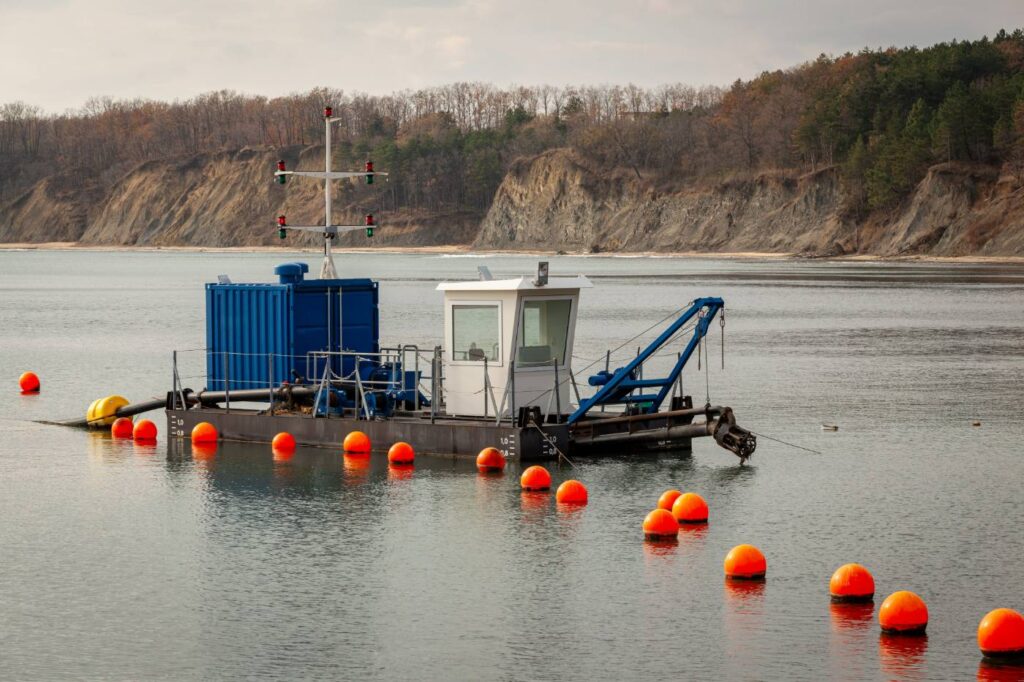
When planning a suction dredge rental, understanding the cost structure is essential for accurate budgeting. Costs can vary significantly based on dredge type, rental duration, maintenance requirements, and other factors. Below are the key cost components associated with renting a suction dredge or cutter suction dredger.
1. Rental Fees
Rental fees are the most straightforward cost element, but they can vary based on rental duration and equipment type.
- Hourly Rates: Ideal for short, quick projects or emergency dredging tasks. Often used for small-scale sediment removal or canal maintenance.
- Daily Rates: Suitable for projects lasting a few days where continuous dredging is necessary.
- Weekly Rates: Cost-effective for longer tasks that require consistent dredging operations.
- Long-Term Rentals: Typically negotiated at lower rates per day or week. Ideal for large-scale dredging projects such as land reclamation or mining.
- Cutter Suction Dredger Rates: Usually higher than standard suction dredges due to the advanced cutting mechanism and higher power capacity.
- Seasonal Variations: Rental rates may increase during peak dredging seasons, such as before or after monsoons.
2. Maintenance and Repair Costs
Maintenance responsibilities can significantly impact the overall cost of suction dredge rental. It’s important to clarify maintenance obligations with the rental provider before finalizing the contract.
- Routine Maintenance: Some providers include basic maintenance like lubrication and minor adjustments in the rental fee.
- Breakdown Coverage: Check if the rental agreement covers unexpected breakdowns or if repairs are charged separately.
- Operator Maintenance: If the equipment requires daily upkeep, it is crucial to have trained personnel to handle routine tasks.
- Cutter Suction Dredger Maintenance: Due to the complexity of the cutter head and hydraulic systems, maintenance costs may be higher than standard suction dredges.
- On-Site Support: Some companies offer maintenance technicians for an additional fee, which can help reduce downtime.
3. Transportation and Setup Charges
Transporting large dredging equipment to and from the project site can add significantly to rental costs.
- Distance-Based Charges: The farther the project site from the rental location, the higher the transportation fees.
- Special Handling Requirements: Cutter suction dredgers may require specialized trucks or trailers for safe transportation.
- Assembly and Installation: Some dredges require on-site assembly, especially larger or modular models, adding to the setup costs.
- Relocation Costs: For projects that require moving the dredge between multiple locations, consider additional transport charges.
- Portable Dredges: Smaller, portable units typically incur lower setup and transportation fees.
4. Operator Fees
Operating a suction dredge requires skilled personnel, especially for complex machinery like cutter suction dredgers.
- Hourly Operator Rates: Depending on experience and certification, rates can vary widely.
- Specialized Operator Charges: Operators skilled in handling cutter suction dredgers may charge more due to the technical expertise required.
- Training Costs: If your team lacks experienced operators, consider training expenses or hiring directly from the rental provider.
- Safety Protocol Training: Some projects may require certified training for safety and compliance, which can be an added cost.
5. Insurance and Liability
Insurance is a critical aspect of suction dredge rental to protect against accidents, breakdowns, or environmental damage.
- Liability Coverage: Essential for protecting the renting company from damages caused during dredging.
- Equipment Damage Insurance: Covers repairs or replacements if the dredge is damaged during use.
- Third-Party Liability: Protects against claims related to environmental impact or property damage.
- Environmental Compliance: Check if the insurance policy covers environmental fines or remediation costs.
- Cutter Suction Dredger Specifics: Due to their higher operational risks and mechanical complexity, insurance premiums may be higher compared to standard dredges.
6. Additional Costs
Apart from the primary cost factors, there are several additional expenses to account for when renting a suction dredge.
- Fuel and Power Costs: Running large pumps and cutter heads requires substantial fuel, often billed separately.
- Consumables: Items like lubricants, cutter head blades, and pipe replacements can add up, especially on longer projects.
- Site-Specific Requirements: Permits, environmental assessments, and safety measures tailored to the project location.
- Disposal Fees: If the dredged material requires special disposal or treatment, these costs must be factored in.
- Monitoring Equipment: Rental of additional monitoring devices to track dredging performance or environmental impact.
Properly assessing all these cost elements when planning a suction dredge rental helps avoid unexpected financial burdens and ensures a well-organized project budget. Balancing the rental duration with operational needs and maintenance responsibilities will optimize overall expenses and project efficiency.
Factors That Influence Rental Costs
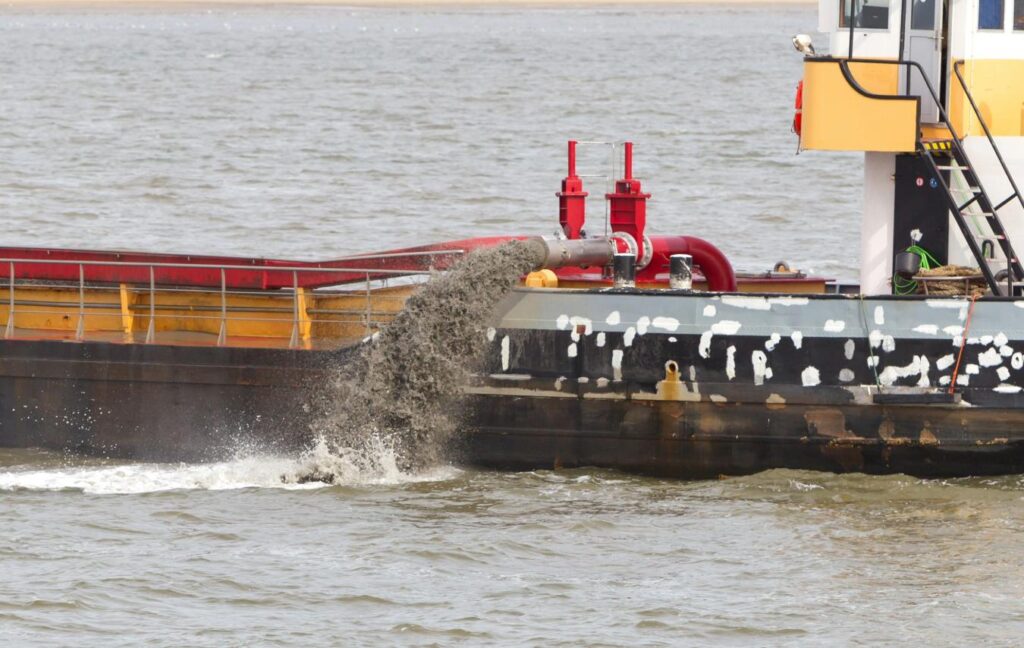
Understanding the factors that affect suction dredge rental costs can help businesses make informed decisions and optimize their budget. From the type of dredge to the supplier’s reputation, each aspect plays a role in determining the overall expenses. Here are the key factors to consider when renting a suction dredge or cutter suction dredger.
1. Dredge Type
One of the most significant factors influencing suction dredge rental costs is the type of dredge selected. Different dredges are designed for specific tasks, and the complexity of their design affects their rental price.
- Standard Suction Dredge: Typically more affordable due to simpler construction and lower power requirements. Suitable for soft sediment removal in shallow waters.
- Cutter Suction Dredger (CSD): Generally more expensive because of their advanced cutter head mechanisms and higher operational capacity. Ideal for compacted soils, clay, or mixed sediments.
- Why CSDs Cost More: These dredgers feature a rotating cutter head to break up dense materials before suction, requiring robust hydraulic systems and skilled operators. Their versatile application and ability to handle tough dredging conditions make them a premium choice, thereby increasing rental costs.
- Additional Attachments: Renting extra components, such as specialized cutter heads, can also raise the cost.
2. Project Duration
The length of the rental period significantly impacts the overall cost of a suction dredge rental. Rental agreements are typically structured to offer discounts for longer commitments.
- Short-Term Rentals: Ideal for emergency dredging or small projects. These tend to have higher per-day rates.
- Long-Term Rentals: More economical for extended dredging projects, such as land reclamation or ongoing canal maintenance. Rates are often reduced when renting for weeks or months.
- Seasonal Rates: Some suppliers adjust rates based on peak demand periods, such as pre-monsoon maintenance.
- Flexible Terms: Check if the rental provider offers options to extend the rental period without incurring high additional fees.
3. Equipment Condition
The age and condition of the equipment can also affect rental pricing. Newer models are generally more efficient and reliable but come with higher rental fees.
- Newer Models: These are typically equipped with advanced features like GPS mapping and automated controls, making them more efficient but costlier.
- Older Units: Often available at reduced rates but may lack modern enhancements. Maintenance frequency may be higher, leading to potential downtime.
- Maintenance Records: Choose a well-maintained older unit to save on costs without compromising reliability.
- Upgraded Cutter Heads: Newer cutter suction dredgers may have more efficient, wear-resistant heads, justifying their higher rental cost.
4. Operational Complexity
Dredging tasks vary in complexity, and projects that require specialized techniques or precision work can increase rental expenses.
- Simple Dredging Tasks: Removing loose sediment or cleaning shallow canals typically requires less powerful equipment, reducing costs.
- Complex Dredging Operations: Projects that involve breaking up hard soil, deep excavation, or precise sediment placement often require cutter suction dredgers. These operations not only necessitate advanced equipment but also skilled operators, increasing both rental and labor costs.
- Custom Modifications: In some cases, adapting the dredge to unique project requirements (like attaching custom pipeline lengths or specialized heads) may incur additional charges.
- Operator Expertise: If the project demands experienced personnel to handle challenging environments, operator fees may further impact the budget.
5. Supplier Reputation
Choosing a reliable suction dredge rental provider can influence both costs and project success. Established suppliers often charge a premium for high-quality, well-maintained equipment and comprehensive support services.
- Reputation for Reliability: Providers with a track record of maintaining their equipment and offering technical support may charge higher rates.
- Service Packages: Some companies include maintenance, operator training, and on-site assistance in their rental contracts, justifying the higher upfront costs.
- Customer Support: Responsive customer service can help minimize downtime and address operational issues promptly, adding value to the rental package.
- Quality Assurance: Opting for a reputable supplier reduces the risk of unexpected breakdowns, which can save money and time during the project.
Key Considerations Before Renting a Suction Dredge
When opting for a suction dredge rental, it’s crucial to assess several factors to ensure that the equipment and operations align with the project’s needs. From understanding dredging requirements to ensuring environmental compliance, thorough planning helps minimize disruptions and maximize efficiency. Here are the key considerations to keep in mind when renting a suction dredge or cutter suction dredger.
1. Project Requirements
Before finalizing a suction dredge rental, it’s essential to define the specific needs of your dredging project. Identifying the dredging volume, sediment type, and expected duration will help you choose the most suitable equipment.
- Dredging Volume: Estimate the total volume of sediment to be removed. Larger volumes may necessitate a more powerful cutter suction dredger.
- Sediment Type: Determine whether the material is loose (like silt and sand) or compacted (like clay and gravel). Standard suction dredges are ideal for softer sediments, while cutter suction dredgers are more effective for harder, denser materials.
- Project Duration: Calculate the timeline, as long-term rentals may be more economical. Consider whether continuous dredging or intermittent operations are needed.
- Operational Depth: Assess how deep the dredging will take place to ensure the chosen dredge can operate efficiently at that depth.
- Discharge Requirements: Identify where the sediment will be deposited, whether onshore, in containment ponds, or at processing facilities.
2. Site Accessibility
The project location plays a vital role in selecting the right suction dredge rental. Some dredging sites are easy to access, while others may pose logistical challenges.
- Remote Locations: Dredging in remote or hard-to-reach areas requires portable dredges that can be transported without specialized vehicles.
- Waterway Restrictions: Narrow canals or shallow waters may limit the size and type of dredge you can deploy.
- Terrain Considerations: If the site has obstacles like rocks or submerged debris, a cutter suction dredger might be necessary to break through compacted materials.
- Local Infrastructure: Assess whether there is adequate access for equipment transport, setup, and maintenance.
- On-Site Storage: Consider where the dredge will be stationed when not in use, especially for longer rental periods.
3. Equipment Size and Capacity
Matching the dredge size to the project scope is essential to maintain cost efficiency and operational effectiveness.
- Smaller Dredges: Ideal for light sediment removal, small-scale canal maintenance, or short-term projects.
- Medium-Sized Dredges: Suitable for moderate tasks like harbor cleaning or mining lighter minerals.
- Large Cutter Suction Dredgers: Necessary for heavy-duty applications such as land reclamation, deep harbor dredging, or mining compacted sediment.
- Pump Capacity: Ensure that the dredge’s pump can handle the volume and density of the material to be removed.
- Mobility: Portable dredges are useful when frequent relocation is required, while stationary dredges are more suitable for long-duration projects at fixed sites.
4. Environmental Compliance
Dredging activities can impact local ecosystems, so it’s crucial to adhere to environmental regulations. Before proceeding with suction dredge rental, verify compliance requirements.
- Permitting: Obtain necessary permits from local authorities to ensure legal compliance. This may include water discharge permits or sediment relocation approvals.
- Sediment Testing: Conduct preliminary testing to assess contamination levels, as hazardous materials may require specialized dredging methods.
- Turbidity Control: Use sediment curtains or barriers to prevent the spread of disturbed sediments, particularly when working in sensitive environments.
- Noise and Emission Limits: Ensure that the dredge meets local noise and air quality standards. Newer cutter suction dredgers often come with low-emission engines and noise suppression features.
- Waste Disposal: Plan for the proper disposal or reuse of dredged material, whether for land reclamation or safe landfill containment.
5. Operator Skill Level
Efficient operation of a suction dredge or cutter suction dredger requires skilled personnel. Inexperienced operators can lead to equipment damage, inefficient sediment removal, or safety incidents.
- Certified Operators: Hire individuals with certifications relevant to dredge operation, especially when using advanced cutter suction dredgers.
- Training Programs: Some rental companies offer operator training as part of the rental package. Take advantage of these resources to ensure safe and effective usage.
- Safety Protocols: Operators should be well-versed in handling emergencies, such as suction line blockages or equipment malfunctions.
- Supervision Requirements: For complex dredging tasks, a site supervisor with experience in sediment management may be necessary.
- Documentation: Keep records of operator qualifications and safety training to comply with regulatory standards.
Choosing the Right Suction Dredge Rental Service
Selecting the right suction dredge rental service is crucial to the success of your dredging project. Whether you need a standard suction dredge or a cutter suction dredger, partnering with a reliable rental provider ensures operational efficiency and reduces the risk of unexpected challenges. Here are the key factors to consider when choosing a rental service.
1. Supplier Reputation
The reputation of the rental service provider plays a significant role in the quality of equipment and customer support you receive.
- Research Reviews: Check online reviews and testimonials to gauge customer satisfaction. Look for feedback on equipment quality, service reliability, and technical support.
- Certifications and Compliance: Reputable rental providers often have certifications that demonstrate their commitment to safety and quality standards.
- Experience in the Industry: Choose a supplier with extensive experience in suction dredge rental, especially if you require specialized equipment like a cutter suction dredger.
- Client Portfolio: A company that serves reputable businesses or public sector projects is likely to maintain higher standards.
- References: Ask the supplier for references from previous clients who have undertaken similar dredging projects.
2. Equipment Inspection
Before finalizing the suction dredge rental, inspect the equipment thoroughly to ensure it meets project requirements and is in optimal condition.
- Visual Inspection: Look for signs of wear, rust, or damage, especially in critical components like the pump, suction pipe, and cutter head (if applicable).
- Operational Testing: Run the equipment to check suction power, pump efficiency, and cutter performance in the case of cutter suction dredgers.
- Maintenance Records: Request maintenance logs to ensure the dredge has been regularly serviced. Consistent maintenance reduces the risk of breakdowns during operation.
- Replacement Parts: Verify that the supplier provides spare parts, such as cutter blades or suction pipe seals, in case of wear and tear during the rental period.
- Safety Features: Ensure the dredge has functioning safety systems, including emergency shutdowns and pressure monitoring.
3. Rental Agreement Clarity
A clear and comprehensive rental agreement helps prevent disputes and unexpected costs. Review the terms and conditions carefully before signing.
- Cost Breakdown: Understand what is included in the rental fee, such as maintenance, technical support, and fuel.
- Maintenance Responsibilities: Clarify whether the supplier covers regular maintenance or if it is the renter’s obligation.
- Liability Terms: Make sure the agreement specifies who is responsible for damages, breakdowns, or accidents during the rental period.
- Insurance Coverage: Confirm that the rental includes liability insurance and coverage for equipment damage, especially if using high-cost machinery like a cutter suction dredger.
- Payment Terms: Check the schedule for payments, late fees, and any deposit requirements.
- Return Conditions: Understand the inspection criteria when returning the equipment to avoid additional charges.
4. Technical Support
Even the best-maintained equipment can encounter issues during use. Having access to technical support is vital for minimizing downtime.
- On-Site Assistance: Some rental providers offer on-site technicians to assist with setup, maintenance, and troubleshooting.
- Remote Support: Ensure that the supplier offers 24/7 support to address any operational problems that may arise.
- Replacement Policy: Ask if the rental agreement includes the provision of a replacement dredge if the primary equipment fails.
- Operator Training: Reputable providers often offer training for operators, particularly when renting more complex equipment like cutter suction dredgers.
- Troubleshooting Guides: Request operational manuals or quick troubleshooting references to handle common issues.
5. Flexibility
Dredging projects can change in scope or duration, making flexibility in rental agreements essential.
- Rental Extensions: Check whether the provider allows extensions if the project timeline changes. Some suppliers may offer reduced rates for extended periods.
- Cancellation Policies: Understand the terms for early termination, including any penalties or fees.
- Equipment Swap: If the dredge rented initially does not meet project needs, inquire whether it is possible to exchange it for a different model.
- Upgrade Options: Some providers allow for upgrades to larger or more advanced dredges mid-project, which can be particularly useful if project requirements change.
- Replacement Terms: If the rented dredge encounters significant issues, know whether the supplier will replace it at no additional cost.
Conclusion
Renting a suction dredge can greatly benefit projects requiring efficient sediment removal, excavation, or site reclamation. By understanding the costs involved, evaluating the project’s specific needs, and selecting a reliable rental service, businesses can make the most of their suction dredge rental. Whether opting for a standard dredge or a cutter suction dredger, careful planning and proactive management will ensure successful dredging operations with minimized risks and costs.


